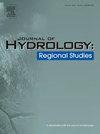Widespread pH increase and geochemical trends in fifty boreal lakes: Evidence, prediction and plausible attribution to climate and permafrost thaw impacts across northeastern Alberta
IF 4.7
2区 地球科学
Q1 WATER RESOURCES
引用次数: 0
Abstract
Study region
This study focuses on 50 boreal lakes and catchments situated in northeastern Alberta, Canada between 55.68°N – 59.72°N and 110.02°W – 115.46°W.
Study focus
Evidence for trends in chemical composition of lakes, including pH increases are provided using Mann-Kendall statistics, geochemical modelling, δ18O, δ2H, and δ13C, which are compared to trend statistics for climate, water balance, and groundwater indicators.
New hydrological insights for the region
Groundwater contributions are generally found to be increasing with water yield and carbon inputs as sites advance along the thaw trajectory. The exception to this is shield lakes which continue to be surface water dominant. Statistical analyses suggest widespread trends, both significant and non-significant, in geochemical parameters across the lake network including pH increases in 46 of 50 lakes. In shale-dominated plateau areas, pH trends are adequately described by changes in HCO3-, attributed mainly to carbon input associated with permafrost thaw. For these lakes, prediction improves little if other variables are considered, whereas for post thaw areas, prediction of pH trends improves if water yield trends are also considered. In sub-regions with appreciable carbonate, pH trend prediction improves significantly if values of δ13CDIC and Dissolved Inorganic Carbon (DIC) are also considered. We postulate that recent pH trends across the region may only be temporary and that lake acidification may yet occur once permafrost thaw and related carbon imports diminish.
求助全文
约1分钟内获得全文
求助全文
来源期刊

Journal of Hydrology-Regional Studies
Earth and Planetary Sciences-Earth and Planetary Sciences (miscellaneous)
CiteScore
6.70
自引率
8.50%
发文量
284
审稿时长
60 days
期刊介绍:
Journal of Hydrology: Regional Studies publishes original research papers enhancing the science of hydrology and aiming at region-specific problems, past and future conditions, analysis, review and solutions. The journal particularly welcomes research papers that deliver new insights into region-specific hydrological processes and responses to changing conditions, as well as contributions that incorporate interdisciplinarity and translational science.
 求助内容:
求助内容: 应助结果提醒方式:
应助结果提醒方式:


